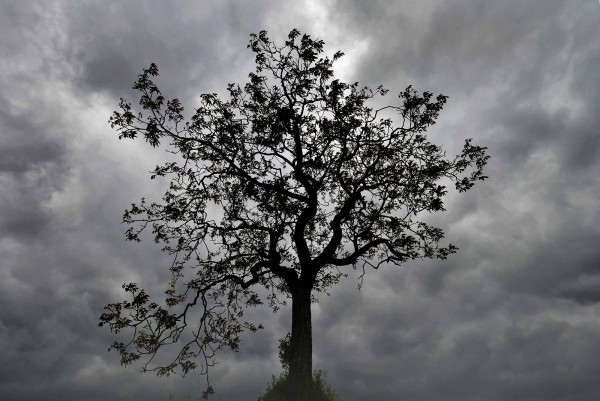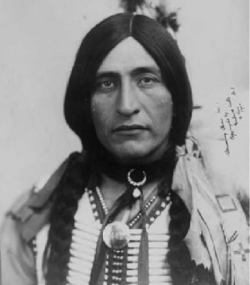Why is it so difficult to get people to act in the face of climate change? Why do the media cover ecology in such a negative way? The more I research, the more complicated it seems and the deeper the causes closely linked to our western way of thinking.
But, first, let me tell the story of the tree people.
Part 1- Renew the myth of mother earth
The story of the tree people
Once upon a time a community lived in a tree lost in an endless desert. Compared to the size of the desert, the tree was tiny. But, for these people the tree was everything. It was huge and reassuring. These people were aware of themselves and their mortality – they experienced fear, suffering, pain, but also joy, happiness and fulfilment. Since ancient times, they were born, ate, loved, hated and died in harmony with this tree of life.
Thanks to their intelligence, these people developed a language and shared knowledge. They made marvellous discoveries and mastered complex arts. They were so successful and healthy that they reproduced and became numerous. Over time, they forgot to pay attention to the health of the tree.
But, one day, they noticed that the tree was not reacting like usual. The leaves fell more quickly, the buds didn’t grow as densely and the new fruit weren’t as beautiful. Sometimes, the tree trembled producing serious damage. What was happening to the tree? Who was responsible? How could they solve the problem? After thorough research, the community’s elders declared that the problem came from the people living in the tree and the solutions must also came from, and only from, them.

© Jean-Louis Aubert Photographe www.jeanlouisaubert9.com
This announcement seemed so incredible that most people didn’t want to believe it. Others remained stunned. Until then, the tree had maintained its natural balance by itself without anyone needing to worry about. But, now they needed to understand everything, start again and change what had led to such a catastrophic situation? They needed to become responsible for the life of the tree and manage the balance together. The tree people weren’t yet very well organized or very numerous. How could they take such important decisions?
No one really knew what to do about the situation. The tree stood alone in the desert, there weren’t any other tree dwellers to give them advice or tell them what to do. It was quite terrifying. However, a few of them set into action and started to think. How could they protect the tree that protects its people? Could their intelligence help save them all?
Let’s call this period the Great Crisis of the Tree People.
No human has ever beaten climate change.
Like the tree people, we have never faced the phenomenon of climate change. “In 2 million years, man has never confronted what is happening before his astonished eyes,” summarises journalist Fabrice Nicolino in an interview for Reporterre, ʺWe need to invent something newʺ. This is a “larger than life” problem and concept that is so huge on a human scale that we find it hard to imagine. The number of storms and hurricanes is on the up, temperatures are rising and the weather is “strange” and “not like usual”.
Europe has experienced record temperatures – in 2015, it reached 40.3°C on 5 July in Kitzingen, Germany and 38.2°C in Maastricht, Netherlands, ʺLes records de la canicule européenne de 2015ʺ. But, these difficult conditions, don’t stop us from living. For the time being, plants and trees – the source of food and energy for all land-living mammals – resist.
Unable to understand this phenomenon using our senses, we’re now trying to give it a concrete form through language. The danger is taking on a completely unprecedented, unpredictable and intangible form explains Alexandra d’Imperio in her article Pourquoi tout le monde se fiche du climat : “The enemy isn’t easy to identify, it’s intentions are vague and its impact unclear. The emotional part of our brain doesn’t receive any clear warning signals.”
We are familiar with the threat of terrorism and war where the enemy has a human form. We can beat an identifiable enemy. Our ancestors prepared us to confront these challenges, in particular through the great myths told by poets like Homer. But, The Iliad and the Odyssey give us no clue about how to resolve this unprecedented crisis. Symbiotic economy researcher and co-scriptwriter of “Home”, Isabelle Delannoy explained in an interview with the Place to B about storytelling & ecology that “We now realise that our vision of the world was wrong. The human vision of the world order is founded upon mythology. The ecological crisis is a crisis of mythology.”
Mythology and the myth of the male warrior
For 3,000 years, Greek mythology told stories about great battles between great peoples. This mythology, which underpins western thought, values the bravery of the male warrior through epic moments like the Battle of Troy. Male heroes like Hector, Agamemnon, Achilles and Ulysses were inspired by these constantly renewed stories, which promote male heroism, courage, fighting skills, physical force, cunning, sense of duty, justice and honour.
These key values in western thinking have become invisible, but they exist everywhere and structure the way we work, exchange and interpret or talk about the world. These myths enable us to understand and organise our chaotic reality based on a system of values, to find meaning and find our place within its movement. In the words of linguist Georges Dumézil, a specialist in narratives structures in mythology, “myths express through drama the ideology of a society, it keeps the values it recognises and the ideals its pursues in our consciousness from generation to generation.” Heur et Malheur du guerrier, 1969.
Today, European and American companies reinforce the values of the male warriors in their communication, brands, adverts and, increasingly, their web content that tells ever more elaborate stories. In 2002, American Marketing Specialist Laurence Vincent observed in Legendary Brands that ʺthe secret to the (…) success of companies (…) is the narrative that communicates the underlying brand philosophy.ʺ And, brand specialist Georges Lewi doesn’t hesitate to make a parallel between Greek mythology and brands in his bestseller ʺMythologie des marques, quand les marques font leur storytellingʺ, 2009.
We find these values exalted in popular American culture and the myth of the Conquest of the West. The powerful industry of Hollywood tells stories about wars and violent battles justified by a Manichean vision of the world. America, its spirit, lifestyle, values, acts of bravery, passion for success – whether in space discovery, technology, internet or cinema – have been spread throughout the world and fascinate young (and less young) people across the continents.
But, what can the bravest warriors do against a hurricane, storm, flood or bad harvests?
The model of the feminine myth and our relationship with “mother earth”
John Truby, screenplay specialist and famous American author of ʺStory Anatomyʺ, which is considered a referential work by scriptwriters, calls for a return to the model of the feminine myth. In his master class “Writing the new myth stories”, he describes how the first civilisations passed down the myth of a nurturing goddess. These stories came from peoples for whom agriculture and plants played a central role.
These myths included two main elements:
– rebirth and the cycle of life – the feminine myth refers to birth, death and rebirth
– the idea that the woman brings about physical and spiritual transformation. She initiates us in the mysteries of life and the myth moves from a physical transformation to a spiritual one.
Then, 3,000 years ago, the myth of the male warrior replaced and overshadowed the feminine version. For John Truby, the disappearance of the feminine myth is responsible for a profound and essential misunderstanding about who we are. It’s the reason why he encourages screenwriters and writers to reconnect with the older model of the feminine goddess who gives birth to the world.
In the myth of the male warrior, living things are bartered and make it possible to win wars. We need to find resources we don’t have at hand – by buying them or taking them by force – and accumulate treasure and conquests as signs of victory. Gradually, wars were not only won using weapons, but also by possessing resources. It involved buying everything in order to continue dominating and crushing the enemy by mastering production.
In myths about mother earth, passed on by ancient pastoral cultures and the American Indians, the earth cannot be bought. It is sacred. This is how one of the Blackfeet chefs talked about the earth in the early 19th century “It is worth more than money. It will always be there. It will not perish even in the flames of a fire. As long as the sun shines and waters runs, this earth will give life to man and animals. We cannot sell the life of men or animals, that is why we can not sell this earth.”

Luther Standing Bear
Sioux chef Luther Standing Bear, born in 1869, talked about the Lakota Indians, who were filled with compassion and love for nature. The Lakotas loved the earth and everything coming from the earth, and this attachment increased with age. The elderly were besotted with the earth and couldn’t sit or stand on it without feeling closer to its maternal forces. They experienced a feeling of brotherhood towards all birds and animals. The relationship was so close between some Lakotas and their feathered or furry friends that they were like brothers who spoke the same language (Land of the Spotted Eagle).
In 2016, the Matsés people in Brazil edited an encyclopaedia of their traditional medicine. All this marvellous knowledge that had been collected by the shamans and passed on from generation to generation as part of a long apprenticeship was written exclusively in the matsé language without any scientific plant names or images. Why? To protect themselves from bio-piracy and companies wanting to steal the information, take the resources and create patents in order to make money. This has already happened several times. The Matsés, always in a close relationship with nature, have maintained a deep relationship with the earth and the source of life. Their system of values is different from ours in the west and doesn’t create the same myths. They value the relationship between man and the earth and respect all forms of life. For them, money doesn’t mean victory: “Amazon tribe creates 500-page traditional medicine encyclopaedia”.
This is the same story that Pierre Rabhi has successfully told and renewed in France. Storytelling professor Mireille Pacquet highlights the modernity of his approach, “In many ways, he is similar to traditional storytellers but with a fairer, more realistic and modern vision.” It is also the story embodied by Anaïs Kerhoas, the unforgettable heroine in the documentary Anaïs goes to war, in which a young 24-year old woman decides to grow her own aromatic plants against the advice of her loved ones and farmers who find her too beautiful to work in the fields.

Photo extract from the article Avec ses Tisanes, Anaïs réveille tout le monde, Ouest France
(Read Part II: Changing the way we see the world)



